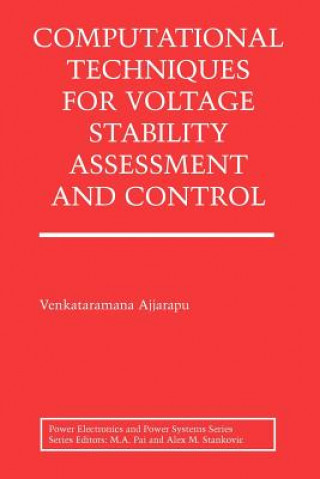
Doručení
Nákupní rádce





Nehodí se? Vůbec nevadí! U nás můžete do 30 dní vrátit
 Dárkový poukaz
V libovolné hodnotě
Dárkový poukaz
V libovolné hodnotě
S dárkovým poukazem nešlápnete vedle. Obdarovaný si za dárkový poukaz může vybrat cokoliv z naší nabídky.
Computational Techniques for Voltage Stability Assessment and Control
 Angličtina
Angličtina
 467 b
467 b
30 dní na vrácení zboží
Mohlo by vás také zajímat


This book provides comprehensive details on continuation power flow, and reviews concepts in bifurcation theory and continuation methods for assessing power system voltage stability. The author proposes a uniform framework that provides computational approaches for both short-term and long-term voltage stability phenomena. Readers can access the author s web-based simulation tools, which are based on the advice in this book, to simulate tests of systems up to the size of 200 busses.Voltage stability is a critical issue in the secure operation of the restructured power system. Poor voltage conditions lead not only to voltage collapse in the system but can also induce oscillatory instability that may cause a loss of synchronism. A critical question is how to estimate the distance to voltage instability given the present state of the system.§Computational Techniques for Voltage Stability Assessment and Control brings together in one place the computational tools necessary to compute the voltage stability margin. The basic computational tool for tracing the P-V curve and equilibria tracing is the continuation power flow. This technique as well as the algorithm is explained in detail by the author. Sensitivity of the voltage stability margin to various parameters in the system is discussed extensively both theoretically and in a numerical context. §The key concepts of both saddle node and Hopf bifurcation are covered. These are illustrated with the differential-algebraic equation (DAE) model of the system. The model is complex enough to include Load Tap-Changing transformers as well as HVDC models. The dynamic model of the generating unit includes the exciter since it plays a crucial role in voltage stability. A promising decoupled dynamic simulation technique is introduced for time domain analysis. §Computational Techniques for Voltage Stability Assessment and Control provides the computational tools and algorithms needed for development of on-line voltage security assessment
Informace o knize
 Angličtina
Angličtina
Kategorie




 Jak nakupovat
Jak nakupovat


























